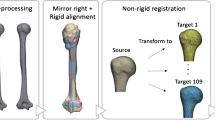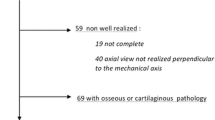Abstract
Purpose
Positioning existing humeral implants into Asian patients poses significant challenges due to the inconsistent statistical shapes between Western population and Asian population. Current humeral orthopedic fixation devices and implants have a generic shape and are not designed for Asian patients who exhibit different sizes and shapes compared to their Western counterparts for which present day designs have been based on. To address this problem, it is necessary to develop Asian-specific implants that accommodate the morphology of Asian humeri. Existing morphological studies of humeri in Asian populations are rare and most previous analyses are either based on the manual measurement of dry bones or the use of dual energy X-ray absorptiometry scans. The purpose of this pilot morphological study is to explore the characteristics of Asian humeri using statistical atlas-based analysis.
Methods
Forty-four CT scans of normal upper limbs were obtained from the National University Hospital, Singapore and used to construct statistical humerus atlases. The atlases were subsequently used to study the morphology of the humeri in an Asian population. Humeral shapes of different patient clusters were analyzed based on statistical shape models. Comparison between different clusters was conducted with regard to centerline, length, width and surface curvature.
Results
The statistical humerus atlases reflected the mean shape and modes of variation of humeri in an Asian population. Analyses based on these atlases indicated that curvature and shape of the internal humeral canal were similar in males and females while humeral length and width were greater in males. Most importantly, surface curvatures were explicitly different between clusters.
Conclusion
Morphologic analysis based on statistical atlases is novel and useful to characterize the Asian humerus. The humerus demonstrates gender-specific morphology. This unique approach provides information that is useful to the clinician and biomedical engineer, not only in the modification of current or design of future humeral implants, but also in the precise dynamic positioning of Asian-specific humeral implants to Asian patients. Our findings support the need for further development of humeral implants, curvilinear robotics, and the questioning of whether gender-specific devices are necessary.











Similar content being viewed by others
References
Adili A (2004) Robot-assisted orthopedic surgery. Surg Innov 11(2):89–98
Gosling T, Westphal R, Hufner T, Faulstich J, Kfuri M Jr, Wahl F, Krettek C (2005) Robot-assisted fracture reduction: a preliminary study in the femur shaft. Med Biol Eng Comput 43(1):115–120
Ren H, Vasilyev NV, Dupont PE (2011) Detection of curved robots using 3D ultrasound. Intelligent robots and systems (IROS), 2011 IEEE/RSJ International Conference on IEEE, 2083–2089
Shoham M, Burman M, Zehavi E, Joskowicz L, Batkilin E, Kunicher Y (2003) Bone-mounted miniature robot for surgical procedures: concept and clinical applications. IEEE Trans Rob Autom 19(5):893–901
Dupont PE, Gosline A, Vasilyev N, Lock J, Butler E, Folk C, Cohen A, Chen R, Schmitz G, Ren H, del Nido P (2012) Concentric tube robots for minimally invasive surgery. Hamlyn Symp Med Robot 7:8
Dupont PE, Lock J, Itkowitz B, Butler E (2010) Design and control of concentric-tube robots. IEEE Trans Robot 26(2):209–225
Ren H, Dupont PE (2011) Artifacts reduction and tubular structure enhancement in 3d ultrasound images. In: International Conference of the IEEE Engineering in Medicine and Biology Society, EMBC
Ren H, Dupont PE (2012) Tubular enhanced geodesic active contours for continuum robot detection using 3d ultrasound. In: Robotics and Automation (ICRA), 2012 IEEE International Conference on IEEE, pp 2907–2912
Yaniv Z, Joskowicz L (2005) Precise robot-assisted guide positioning for distal locking of intramedullary nails. IEEE Trans Med Imaging 24(5):624–635
Chung JH, Ko SY, Kwon DS, Lee JJ, Yoon YS, Won CH (2003) Robot-assisted femoral stem implantation using an intramedulla gauge. IEEE Trans Robot Autom 19(5):885–892
Wolinsky PR, McCarty E, Shyr Y, Johnson K (1999) Reamed intramedullary nailing of the femur: 551 cases. J Trauma Acute Care Surg 46(3):392–399
Reichert I, McCarthy I, Hughes S (1995) The acute vascular response to intramedullary reaming. Microsphere estimation of blood flow in the intact ovine tibia. J Bone Joint Surg 77(3):490–493
Iscan MY, Loth SR, King CA, Shihai D, Yoshino M (1998) Sexual dimorphism in the humerus: a comparative analysis of Chinese, Japanese and Thais. Forensic Sci Int 98(1):17–29
Patil G, Kolagi S, Ramadurg U (2011) Sexual dimorphism in the Humerus: south Indians. J Clin Diagn Res 5(3):538–541
Somesh MS, Prabhu LV, Shilpa K, Pai MM, Krishnamurthy A, Murlimanju BV, Murlimanju B (2011) Morphometric study of the Humerus segments in Indian population. Int J Morphol 29(4):1174–1180
Clark EM, Ness AR, Tobias JH (2007) Gender differences in the ratio between humerus width and length are established prior to puberty. Osteoporos int 18(4):463–470
Tanner JM, Hughes PC, Whitehouse RH (1981) Radiographically determined widths of bone muscle and fat in the upper arm and calf from age 3–18 years. Ann Hum Biol 8(6):495–517
Ahmad OM, Ramamurthi K, Wilson KE, Engelke K, Bouxsein M, Taylor RH (2009) 3d structural measurements of the proximal femur from 2d dxa images using a statistical atlas. In: SPIE Medical Imaging International Society for Optics and Photonics, vol 7260, pp 726005-1–726005-8
Chintalapani G, Ellingsen LM, Sadowsky O, Prince JL, Taylor RH (2007) Statistical atlases of bone anatomy: construction, iterative improvement and validation. Medical Image Computing and Computer-Assisted Intervention-MICCAI. Springer, Berlin, pp 499–506
Chintalapani G, Murphy R, Armiger RS, Lepisto J, Otake Y, Sugano N, Taylor RH, Armand M (2010) Statistical atlas based extrapolation of ct data. In: SPIE Medical Imaging, International Society for Optics and Photonics, pp 762539–762539
Cootes T, Taylor C, Cooper D, Graham J (1995) Active shape models-their training and application. Comput Vis Image Unders 61(1):38–59
Kang X, Ren H, Li J, Yau WP (2012) Statistical atlas based registration and planning for ablating bone tumors in minimally invasive interventions. In: Robotics and Biomimetics (ROBIO), 2012 IEEE International Conference on IEEE, pp 606–611
Lamecker H, Seebass M, Hege HC, Deuflhard P (2004) A 3d statistical shape model of the pelvic bone for segmentation. In: Proceedings of SPIE Medical Imaging 2004: Image Processing, vol 5370, pp 1341–1351
Moghari MH, Abolmaesumi P (2008) Global registration of multiple bone fragments using statistical atlas models: feasibility experiments. In: Engineering in Medicine and Biology Society, EMBS 2008, 30th Annual International Conference of the IEEE, pp 5374–5377
Querol LB, Buchler P, Rueckert D, Nolte LP, Ballester MAG (2006) Statistical finite element model for bone shape and biomechanical properties. Medical Image Computing and Computer-Assisted Intervention-MICCAI, Springer, Berlin, Heidelberg, pp 405–411
Sadowsky O, Ramamurthi K, Ellingsen LM, Chintalapani G, Prince JL, Taylor RH (2006) Atlas-assisted tomography: registration of a deformable atlas to compensate for limited-angle cone-beam trajectory. In: Biomedical Imaging: Nano to Macro, 2006 3rd IEEE International Symposium on IEEE, pp 1244–1247
Wu C, Murtha P, Jaramaz B (2009) Femur statistical atlas construction based on two-level 3d non-rigid registration. Comput Aided Surg 14(4–6):83–99
Wu C, Murtha PE, Mor AB, Jaramaz B (2005) A two-level method for building a statistical shape atlas. CAOS, Helsinki, Finland
Yao J, Taylor R (2003) Non-rigid registration and correspondence finding in medical image analysis using multiple-layer flexible mesh template matching. Intern J Pattern Recognit Artif Intell 17(7):1145–1165
Daruwalla ZJ, Courtis P, Fitzpatrick C, Fitzpatrick D, Mullett H (2010) Anatomic variation of the clavicle: a novel three-dimensional study. Clin Anat 23(2):199–209
Daruwalla ZJ, Courtis P, Fitzpatrick C, Fitzpatrick D, Mullett H (2010) An application of principal component analysis to the clavicle and clavicle fixation devices. J Orthop Surg Res 5(1):21
Rueckert D, Frangi AF, Schnabel JA (2001) Automatic construction of 3d statistical deformation models using non-rigid registration. In: Medical Image Computing and Computer-Assisted Intervention-MICCAI, Springer, Berlin, Heidelberg, pp 77–84
Zheng G (2011) Personalized X-ray reconstruction of the proximal femur via intensity-based non-rigid 2d–3d registration. In: Medical Image Computing and Computer-Assisted Intervention-MICCAI, Springer, Berlin, Heidelberg, pp 598–606
Ren H, Wu K, Kang X (2013) Surgical navigation and planning with minimum radiation in orthopaedic interventions. Bone Joint J 95–B:53
Benameur S, Mignotte M, Parent S, Labelle H, Skalli W, de Guise J (2003) 3d/2d registration and segmentation of scoliotic vertebrae using statistical models. Comput Med Imaging Graph 27(5):321–337
Fleute M, Lavalle S (1999) Nonrigid 3-D/2-D registration of images using statistical models. In: Medical Image Computing and Computer-Assisted Intervention-MICCAI99, Springer, Berlin, pp 138–147
Markelj P, Tomazevic D, Likar B, Pernus F (2012) A review of 3d/2d registration methods for image-guided interventions. Med Image Anal 16(3):642–661
Seim H, Kainmueller D, Heller M, Lamecker H, Zachow S, Hege HC (2008) Automatic segmentation of the pelvic bones from ct data based on a statistical shape model. VCBM, Delft, pp 93–100
Wu K, Wong KL, Daruwalla ZJ, Murphy D, Ren H (2013) Statistical Humerus Atlas for Optimal Design of Asian-Specific Humerus Implants and Associated Intramedullary Robotics. In: IEEE International Conference on Robotics and Biomimetics, pp 304–309
Cao J, Tagliasacchi A, Olson M, Zhang H, Su Z (2010) Point cloud skeletons via laplacian based contraction. In: Shape Modeling International Conference (SMI), pp 187–197
Spivak M (1999) A comprehensive introduction to differential geometry. Publish or Perish Press, Berkeley
Ren H, Campos-Nanez E, Yaniv Z, Banovac F, Hata N, Cleary K (2014) Treatment planning and image guidance for radiofrequency ablation of large tumors. IEEE J Biomed Health Inform 18(3):920–928
Ren H, Guo W, Ge SS, Lim W (2014) Coverage planning in computer-assisted ablation based on genetic algorithm. Comput Biol Med 49:36–45
Ren H, Lim CM, Wang J, Liu W, Song S, Li Z, Herbert G, Tse Z, Tan Z (2013) Computer assisted transoral surgery with flexible robotics and navigation technologies: a review of recent progress and research challenges. Crit Rev Biomed Eng 41:365–391
Kang X, Ren H, Li J, Yau W-P (2014) Computer-assisted bone tumour ablation using sparse radiographs. Adv Robot 28(5):303–315
Acknowledgments
This work is supported by Singapore Academic Research Fund under Grants R397000139133 and R397000157112 and NUS Cross Faculty Research Grant R-397-000-177-133 (Statistical Shape Analysis for Development of Humerus Implants that Suits the Asian Population) awarded to Dr. Hongliang Ren. Also, we would like to thank Dr. Emmanuel Audenaert from Ghent University Hospital for sharing the algorithm on rigid registration and also for the fruitful discussions.
Author information
Authors and Affiliations
Corresponding author
Rights and permissions
About this article
Cite this article
Wu, K., Wong, K.L., Ng, S.J.K. et al. Statistical atlas-based morphological variation analysis of the asian humerus: Towards consistent allometric implant positioning. Int J CARS 10, 317–327 (2015). https://doi.org/10.1007/s11548-014-1084-y
Received:
Accepted:
Published:
Issue Date:
DOI: https://doi.org/10.1007/s11548-014-1084-y




